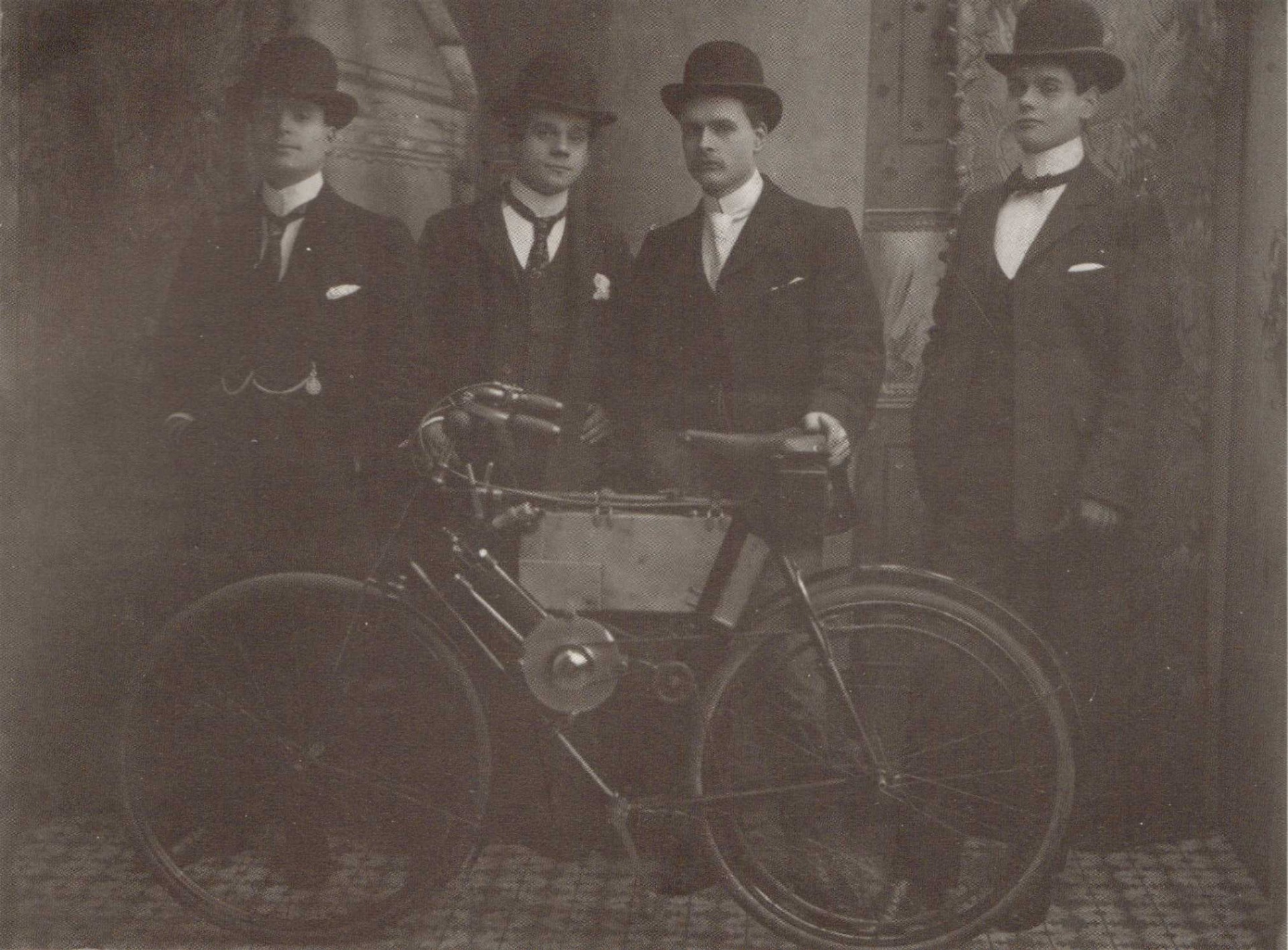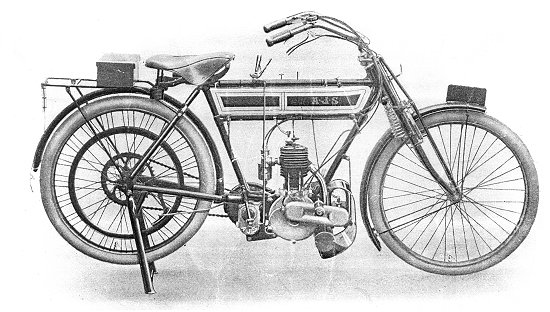
AJS Motorcycles
Click here to go back to the main "History" page.
A new company called "A. J. Stevens & Company Ltd" (Co reg number 105749) was formed on 14 November 1909 so that the brothers could design and manufacture motorcycles. The Directors and Shareholders were George, Harry, Jack, and Joe (Jnr).
The brothers acquired freehold premises in Retreat Street, opposite the Stevens Screw Company's works.
Harry Stevens designed the first two AJS motorcycles, models 'A' and 'B'. Production was completed in August 1910 and they were exhibited at Olympia in November of that year.
Model 'A' is pictured below:

Model 'B' is pictured below

Jack Stevens, was particularly keen to promote the business via motor sport, so in 1911 he entered one of two model 'B's in the Isle of Man TT Junior race. Following a tumble and wasting valuable time straightening the forks, Jack came in 16th on AJS's official entry, one place behind a private owner J.D. Corke on the same AJS motorcycle. AJS did not compete in the 1912 TT, but they were 10th in the 1913 Junior race.
In 1913 the model 'A' was discontinued and the model 'B' updated. The alterations included a 2 or 3 speed gearbox and enclosed chain drive. The model 'D', first displayed at Olympia in 1911 was given a 6hp. V-twin engine, and a sidecar version with a coach built sidecar built by C W Hayward, was introduced. To read more about AJS Sidecars and C W Hayward click here.
By 1914 the AJS motorcycle had grown to 349 cc, with 4 speed gears and chain drive. Luckily the Junior limit for the TT races had been raised to 350 cc. An AJS won 1st, 2nd, 3rd, 4th and 6th place in the Junior race that year. This picture taken from the Wolverhampton History and Heritage website and shows the Stevens brothers and four of the riders in the 1914 Junior Isle of Man T.T.

From left to right - Jack Stevens, Billy Heaton, Harry Stevens, Cyril Williams, George Stevens, Eric Williams, Joe Stevens junior, and Bert Haddock.
In 1914 the company became "A.J. Stevens (1914) Ltd", and to meet the increased demand AJS moved to a new factory in Graiseley House, a short distance south of the Retreat Street premises, which then became the company's office and repair department. The 349-cc machine was most in demand, but the company also produced an 800 cc (6 hp) V-twin.
On 3 November 1916, the Ministry of Munitions prohibited the production of non-military motorcycles, and so AJS changed to manufacturing munitions, but in early 1917 the Ministry received an order from Russia for military vehicles, and AJS was given a contract to fulfil part of the order with it's AJS model "D" machine.
Ministry of Munitions restrictions were lifted in January 1919 and production of an improved 350cc resumed in 1920. The side-valve engine was replaced by a new overhead-valve design. It had internal expanding brakes and a chain primary drive. Cyril Williams won the 1920 Isle of Man TT Junior race on his 350cc. AJS also took the first four places in the 1921 Isle of Man TT, and Howard R Davies won the Senior on the same 350cc AJS, he had raced in the Junior. The first time a 350cc had won the 500cc Senior TT race.
The 1921 Isle of Man Tourist Trophy Junior 350 cc race took place on (Tuesday) 14 June 1921 and the Senior 500 cc was on (Thursday) 16 June 1921. In this year AJS redeemed themselves by completing a hat trick, taking the first four places for a total of six of the top ten places in the Junior 350 cc race. The census taken on 19 June 1921 shows Harry, George and Albert John "Jack" Stevens were boarding at Inglewood, 26 Palace Terrace, Onchan, Isle of Man, with their wives and also sister Lucy and her husband William Hadley, an engineer for the firm. It also shows Charles William Hayward, founder of C W Hayward side car manufacturer, and his wife staying at the same address.
In 1922 Tom Sheard won the Junior on an AJS, with G Grinton, also on an AJS, taking 2nd.
The 1922 motorcycle was to become known as the 'Big Port' because of its large-diameter exhaust port and pipe (initially 1 5⁄8 inches, but changed in successive years). The OHV 350 would be the mainstay of the company's racing efforts until 1927. It was first offered to the public in 1923 and became AJS's most popular
The photograph below (from an article in "Oldbike, Australasia" which can be found here) was taken at the AJS Factory, probably Graiseley Hill in 1924. It shows Joe Stevens Jnr (centre right) with his nephew Hanford Stevens (immediately to his left with his foot on the box)

Below are just some of those photographs taken of the Graiseley Hill Factory in 1927 as part of a publicity drive. The first two are of the Finishing Dept, the next is the Road Test Dept. and the final two are of the Repairs Dept., all at Graiseley Hill. For more pictures of the AJS factories click here
In 1929 the AJS range consisted of:
- M1 Deluxe 996 cc side-valve V-twin - £76. 10s, 0d
- M2 Standard 996 cc side-valve V-twin - £66. 0s. 0d
- M3 Deluxe Touring 349 cc side-valve single - £48. 10s. 0d
- M4 Deluxe Sporting 349 cc side-valve single - £48. 10s. 0d
- M5 Standard Sporting 349 cc side-valve single - £45. 0s 0d
- M6 349 cc overhead-valve single - £54.10s. 0d (twin port), £52. 0s. 0d (single port)
- MR6 Special
Sports 349 cc overhead-valve single - £62. 0s 0d - M7 349 cc overhead-camshaft single - £62. 0s. 0d
- M8 498 cc overhead-valve single - £62. 0s. 0d (twin port), £59. 10s. 0d (single port)
- MR8 Special
Sports 498 cc overhead-valve single - £72 0s. 0d - M9 Deluxe Touring 498 cc side-valve - £54. 0s 0d
- M10 498 cc overhead-camshaft single - £72. 0s. 0d
- M12 Lightweight 248 cc side-valve single - £39, 7s. 6d
Several of these were intended to pull one of the 12 AJS sidecars produced by the company, including sports, touring and commercial models.
In 1927 AJS introduced two new chain-driven overhead-camshaft racing models, the 349 cc K7 and the 498 cc K10. Jimmy Simpson came 3rd on a 350 in the Junior TT and won races in Europe. In 1928 AJS used the overhead-valve engine in the TT. In 1929 there were two machines with an overhead cam, this time the 349 cc M7 and the 498 cc M10. Wal Handley came 2nd in the 1929 Junior TT for AJS. The following year Jimmie Guthrie won the 1930 Lightweight TT on a 250 cc AJS.
In 1931, the AJS S3 V-twin was released, a 496 cc transverse V-twin tourer with shaft primary drive and alloy cylinder heads. It had been expensive to develop and was slow to sell. Even though it held 117 world records, the AJS company was now in financial trouble.
For more information, click on the link below and follow the further links on that page.
A.J.S. Motorcycles (historywebsite.co.uk)
Also see this German website which covers the history of AJS motorcycles, the models, their riders, instruction manuals and other technical documentation as well as heaps of photographs.
Home | Home - Vintage AJS (vintage-ajs.de)
Also
AJS Motorcycles (cybermotorcycle.com)
And